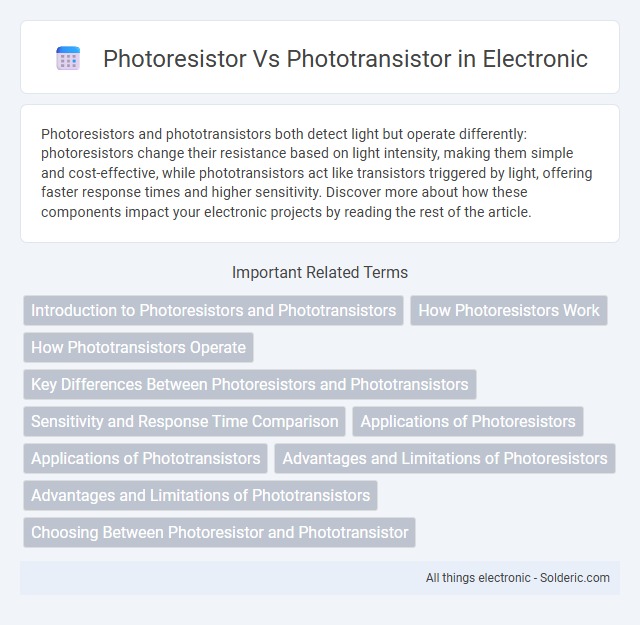Photoresistors and phototransistors both detect light but operate differently: photoresistors change their resistance based on light intensity, making them simple and cost-effective, while phototransistors act like transistors triggered by light, offering faster response times and higher sensitivity. Discover more about how these components impact your electronic projects by reading the rest of the article.
Comparison Table
| Feature | Photoresistor (LDR) | Phototransistor |
|---|---|---|
| Sensitivity | Moderate sensitivity to visible light | High sensitivity to light, faster response |
| Response Time | Slow (milliseconds to seconds) | Fast (microseconds to milliseconds) |
| Output | Resistance varies with light intensity | Current changes proportionally with light |
| Applications | Light meters, street lights, simple light sensing | Optocouplers, automatic lighting, precision sensors |
| Construction | Semiconductor material (cadmium sulfide) | Transistor with light-sensitive base |
| Cost | Low cost | Moderate cost |
| Linearity | Non-linear response | More linear output |
Introduction to Photoresistors and Phototransistors
Photoresistors, also known as light-dependent resistors (LDRs), vary their resistance based on ambient light intensity, making them ideal for simple light-sensing applications. Phototransistors operate like regular transistors but are activated by light, offering faster response times and higher sensitivity compared to photoresistors. Both components are essential in optical detection systems, with phototransistors preferred in applications requiring precise light measurement and rapid switching.
How Photoresistors Work
Photoresistors, also known as light-dependent resistors (LDRs), operate by changing their electrical resistance based on the intensity of light that falls on their semiconductor material. When light photons hit the photoresistor, they excite electrons, reducing the resistance and allowing more current to flow through the circuit. Your choice between photoresistor and phototransistor depends on the application's sensitivity and response speed, as photoresistors typically have slower response times but are cost-effective for ambient light detection.
How Phototransistors Operate
Phototransistors operate by detecting light intensity with a semiconductor material that allows current to flow when exposed to photons, effectively amplifying the electrical signal compared to photoresistors. Unlike photoresistors, which change resistance based on light exposure, phototransistors convert light into current, providing faster response times and higher sensitivity. This makes phototransistors ideal for applications requiring accurate light detection and signal amplification, such as optical switches and light sensors.
Key Differences Between Photoresistors and Phototransistors
Photoresistors, also known as LDRs (Light Dependent Resistors), change their resistance based on light intensity, offering slower response times and lower sensitivity compared to phototransistors, which operate as light-controlled transistors with faster response and higher gain. Phototransistors convert light directly into current, providing better precision in light detection and amplification, making them ideal for applications requiring rapid and accurate light sensing. Your choice between photoresistors and phototransistors depends on the need for response speed, sensitivity, and application-specific requirements such as ambient light monitoring or optical communication.
Sensitivity and Response Time Comparison
Photoresistors exhibit lower sensitivity and slower response times compared to phototransistors, which provide faster and more precise detection of light intensity changes. Your applications requiring rapid light detection and higher sensitivity perform better with phototransistors due to their semiconductor properties that enable quick signal conversion. Photoresistors, however, are more suitable for slower or less sensitive light-sensing tasks where response speed is less critical.
Applications of Photoresistors
Photoresistors are commonly used in light-sensing applications such as street lighting, alarm systems, and camera exposure controls due to their sensitivity to changes in ambient light. Their ability to vary resistance based on light intensity makes them ideal for devices requiring automatic adjustment to lighting conditions. Your projects benefit from photoresistors when precise, low-cost light detection is needed without complex circuitry.
Applications of Phototransistors
Phototransistors are widely used in applications requiring precise light detection and amplification, such as optical sensors, smoke detectors, and automatic lighting controls. Their faster response time and higher sensitivity compared to photoresistors make them ideal for communication systems and encoders used in robotics. If your project demands accurate light measurement with quick switching capabilities, phototransistors offer a superior solution.
Advantages and Limitations of Photoresistors
Photoresistors offer simplicity, low cost, and high sensitivity to visible light, making them ideal for basic light detection applications. Their slow response time and limited spectral sensitivity restrict use in fast-switching or precise wavelength applications. You should consider these advantages and limitations when selecting a component for light sensing needs.
Advantages and Limitations of Phototransistors
Phototransistors offer higher sensitivity and faster response times compared to photoresistors, making them ideal for applications requiring precise light detection and rapid switching. Their electrical gain amplifies weak light signals, enhancing performance in low-light conditions, but this also increases susceptibility to noise and temperature variations. You should consider these advantages and limitations when selecting phototransistors for your light-sensitive electronic projects.
Choosing Between Photoresistor and Phototransistor
Choosing between a photoresistor and a phototransistor depends on your specific light-sensing needs, as photoresistors offer slower response times but are cost-effective and sensitive to varying light levels. Phototransistors provide faster switching speeds, higher sensitivity, and better amplification, making them ideal for precise and rapid light detection in your project. Assess the required response time, sensitivity, and budget to determine the best option for your application.
photoresistor vs phototransistor Infographic

 solderic.com
solderic.com